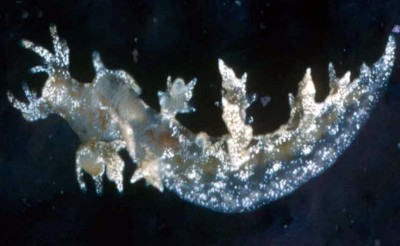

Bornella dotoides
Pola, Rudman & Gosliner, 2009
Order: NUDIBRANCHIA
Suborder: DENDRONOTINA
Family: Bornellidae
DISTRIBUTION
Known only from north coast of Papua New Guinea.
PHOTO
Upper: CASIZ 174952, Papua New Guinea, north of Madang, “The Quarry”, one specimen 7 mm preserved, 12 February 1988, coll: T.M. Gosliner. Photo: T.M. Gosliner.
Lower: Scanning electron micrograph of left half-row of radula (CASIZ 086442, scale bar: 8µm). SEM Photo: M. Pola.
The general body shape is long and tapering, typical for species of Bornella, and the surface is scattered with low pointed tubercles. The body is a translucent whitish brown colour with subepidermal white granules scattered all over. The head is rounded, and bears a lobe-like oral tentacle on each side of the mouth, with seven finger-like papillae of unequal length arranged in two rows. The rhinophore sheath is tall with the whitish rhinophore protruding at the tip. There are three elongate papillae on the front and sides of the upper edge of the rhinophore sheath, and a taller, flat and branched sail-like structure attached posteriorly. The posterior sail carries three or four small papillae of different lengths. Behind the rhinophores are four pairs of dorsolateral processes, followed by two single processes in the dorsal midline. The first two dorso-lateral processes on each side have four papillae, the third dorso-lateral process has only three papillae, and the fourth is simple, lacking any papillae. Two or three bipinnate gills are found on the three anterior dorso-lateral processes, but are absent from the fourth process. The gills are located on the inner surface. The anus is small, located on the right side of the dorsum between the first and second pair of dorsolateral processes and the reproductive opening is on the right side, midway between the rhinophore sheath and the first dorsolateral process.
The preserved adults are small, up to 8 mm in length.
Bornella dotoides can be distinguished from other members of the genus by its opaque white spots and lack of orange pigmentation. The central teeth are very distinctive with very strong denticles on either side of the central cusp. The name dotoides is a reference to the similarity in shape of the dorso-lateral processes, to the cerata of species of the dendronotoidean genus Doto.
-
Pola, M., Rudman, W. B. & Gosliner, T. M. (2009) Systematics and preliminary phylogeny of Bornellidae (Mollusca: Nudibranchia: Dendronotina) based on morphological characters with description of four new species. Zootaxa, 1975, 1-57.
Rudman, W.B., 2009 (January 27) Bornella dotoides Pola, Rudman & Gosliner, 2009. [In] Sea Slug Forum. Australian Museum, Sydney. Available from http://www.seaslugforum.net/factsheet/borndoto
